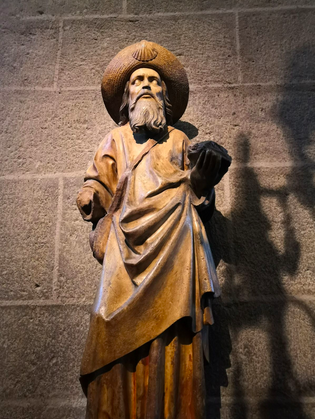Cathedral of Notre Dame
of the Assumption
-

The Cathedral of Notre Dame of the Assumption was built during the 11th and 12 centuries. The sanctuary actually rests on Mount Anis. The next two bays from the sanctuary were built over Gallo-Roman remains (first century BCE to 5th century CE). The other four bays (marked by the pillars) were built as congregations grew and needed more space. These bays rest on huge pilons suspended over the hillside. The Cathedral’s architectural style is Romanesque with a Muslim influence in its arches and multi-colored stones. There are 285 steps up to the Cathedral.
The Hotel de Dieu (halfway up the Cathedral steps to the left) was built as a massive guest house for poor pilgrims toward the end of the 12th century. The early Sisters of St. Joseph ministered to the poor here, too.
This statue of the Black Madonna that sits in the main sanctuary of the Cathedral evokes Mary’s joy in presenting her son, Jesus. It was brought here in 1844 after the original was burned. Marian processions are held in the streets of Le Puy on August 15; thousands of people attend.
This Black Madonna is a replica of the original that King Louis IX brought back from Africa in 1254. The original was burned at Place du Martouret on June 8, 1794, during the French Revolution. It is kept in the small chapel on the left of the nave.
St. Jacques (St. James) and the Camino
Beginning in 950, Le Puy became a major stop on the pilgrimage route to Santiago de Compostela thanks to Bishop Godescale of Le Puy. As the first known pilgrim to the tomb of the Apostle James (which had been discovered a century before), he made Le Puy his symbolic departure point for the Camino. A number of other pilgrimages from other starting points emerged before they declined in popularity during the Renaissance. Since the end of the 20th century, however, there has been a resurgence of pilgrimages. About 15,000 pilgrims per year walk the Camino via Le Puy.
The Assumption of the Virgin Mary overlooks the nave of the Cathedral. The is the name of the Cathedral. The sculpture is by Pierre Vaneau (1653-94).
While you are looking up at the Virgin, look at the shells in the corners. They are a symbol of Saint Jacques de Compostela pilgrimage. Pilgrims wear the shell on their backpacks.
These floor grates open after the morning pilgrimage Mass to allow the pilgrims to begin their 788-mile journey to Santiago de Compostela in northwestern Spain. Healing Stone or Fever Stone was part of the original sanctuary. According to legend, a sick woman received the order to climb the mount. Once at the top, she noticed a flat stone where she lay down and fell asleep. When she awoke, she was healed. Today, pilgrims continue to ask the Virgin for healings. The Our Lady of Mercy statue comes from the 15th century. Touch the stone and feel its energy. It still has healing power. Some people lie on the stone as well.
Healing Stone or Fever Stone was part of the original sanctuary. According to legend, a sick woman received the order to climb the mount. Once at the top, she noticed a flat stone where she lay down and fell asleep. When she awoke, she was healed. Today, pilgrims continue to ask the Virgin for healings. The Our Lady of Mercy statue comes from the 15th century. Touch the stone and feel its energy. It still has healing power. Some people lie on the stone as well.
Look at the wall to the left of the Healing Stone, which lists the bishops who served here in Le Puy. Bishop Henri Cauchon de Maupas (1641-61) is listed. He asked Father Medaille to work with the women who would eventually become the Sisters of St. Joseph. Bishop de Maupas also worked with the Vatican to officially institute the Sisters of St. Joseph as a congregation of the Church.
This marble altar of St. Anne with Blessed Mother as a Child and statue were offered in 1869 by Bishop of Le Puy Le Breton. Devotion to St. Anne began at the end of the 16th century.
King Louis IX (1214-70) went on the 7th and 8th Crusades. He brought the Black Madonna back from Egypt or Ethiopia and gave it to Le Puy. He also brought back the Crown of Thorns, which is regularly kept at Notre Dame Cathedral in Paris. It was saved during the April 15, 2019 fire and was kept in the Louvre during repairs of Notre Dame. The Cathedral re-opens on December 8, 2024.
This painting depicts the procession held on April 22, 1630 celebrates the End of the Pandemic of 1630. This painting has more meaning for us today as we have gone through the Covid pandemic. The men in the middle are carrying the Black Madonna and giving thanks for her mercy.Procession of August 15




